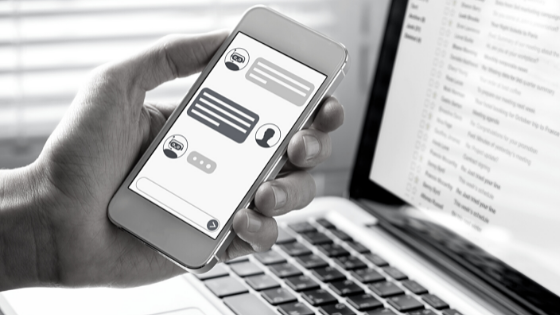Building a quality customer experience is essential to the success of any business. It is as important as your business’ products and services. Thankfully, there are many ways to improve how customers interact with your business.
Introducing automation and personalisation into your customer service system can enhance the consumer’s entire experience. Personalisation provides a customised experience, while automation technology expedites the process.
But, you need to find the right balance.

The Advantages of a Balanced Automated and Personalised Customer Experience
Automated customer service doesn’t always have to feel robotic or bleak. In fact, automation mixed with personalisation is an incredibly powerful business strategy. Although striking a balance between the two is challenging and ever-changing, it contributes to sustained customer success and long-term business growth.
In this guide to balancing personalised and automated customer service, we’ll go over:
- Using automation in customer support and its benefits
- Creating a personalised consumer experience and its benefits
- 3 advantages of a balanced automated and personalised system
- 6 expert tips on balancing automation and personalisation
Using Automation in Customer Support
An automated service enables your consumer to solve issues or access information without speaking to a representative. Instead, businesses use artificial intelligence (AI) and other virtual methods to handle client requests. Some ways to automate customer service include:
- Chatbots
- Interactive voice response systems (IVR)
- Self-service portals
- Frequently asked questions (FAQ)
- How-to guides, resource databases, and more.
These automated strategies help users complete transactions, find answers to their questions, or connect with the appropriate agent or department. AI support also helps identify time-sensitive trouble tickets and ensures the client receives help quickly.
Overall, an automated support model aims to streamline processes for a better customer experience.
The Benefits of Automated Customer Service
Increase the quality of your consumer support output by introducing automation. An automated service holds many benefits for businesses such as:
- Enhanced employee performance – Using automation in customer support reduces a representative’s workload, allowing them to focus on more complex requests. Employee performance improves because agents are able to focus on delivering a quality experience.
- Cost-effective – Automation cuts down on customer service wait times and, in some cases, eliminates the need for customer service reps. Your business delivers a faster, better service while reducing costs with an automated service.
- Provide omnichannel support – Integrating multiple channels of communication and support allows the customer to use their preferred method of communication. Virtual support also enables your business to provide 24/7 support.
- Minimises human error – Everyone makes mistakes, especially when it comes to repetitive or mundane tasks. Human error can be unavoidable in certain situations. And, fixing human mistakes may prove expensive for your business. Automation helps decrease human error by completing some tedious tasks. Think: Using an AI grammar tool when communicating with customers in chats and emails.
Creating a Personalised Consumer Experience
A personalised service experience delivers tailored and individualized assistance to the client. Businesses use personalisation to establish a strong connection with their consumer base. Some examples include:
- Live assistance tailored to individual customers
- Targeted advertisements, pop-ups, and emails
- Promotions, coupon codes, or loyalty programs
- Websites personalised to users’ needs, and more.
Targeted strategies like these promote higher transaction rates and deliver a unique service. Personalisation builds a relationship between the consumer and your business, anywhere clients interact with your brand.
The Benefits of Personalised Customer Support
Developing customised services can take quality service one step further. Here are some benefits of personalising your consumer interactions:
- Customer loyalty – Personalisation establishes a relationship between your business and the customer. This connection fosters consumer loyalty and keeps the client coming back for more.
- Increased revenue – A tailored experience draws customers to your brand and encourages customer retention. According to a study done by Epsilon, 80 percent of customers are more likely to buy from businesses with personalised experiences.
- Improves brand reputation – Customisation leaves a lasting impression on the consumer. Happy customers become unofficial brand advocates through online reviews or word-of-mouth marketing. All of this contributes to a strong brand reputation.
- Stand out from your competitors – A personalised service could be the determining factor when consumers decide on a brand. Providing a unique, tailored experience will set you apart from your competition.
Too Much Personalisation or Automation is Bad for Business
While there are many benefits to both personalised and automated service, too much of either can have negative effects.
Excessive targeting can come off as creepy or intrusive. It can also leave consumers questioning how you obtained their personal information. Such targeting can even prevent customers from doing business with you.
As with everything, there is a time and a place for personalisation. Recommending products based on previous online searches and purchase history is acceptable. But, welcoming a customer by name in a store based on personal data gathered from their device is creepy.
It’s important not to betray a consumer’s trust. Aim to create targeted content that doesn’t overstep the customer’s privacy boundaries.
On the other hand, over-the-top automation can make your business seem cold and inhuman. With excessive automation, there is no connection established between the customer and the brand. This makes it easier for clients to switch to a different service or provider. Too much automation promotes customer disinterest in campaigns, products, services, and more.
Finding the Right Balance
The ideal balance of automation and personalisation in customer service combines the benefits and eliminates the downfalls of both strategies.
For example, where automation feels cold and inhuman, personalisation breathes life into the service. And where personalisation is inefficient, automation can help streamline processes.
In fact, automation can actually help create a personalised experience.
An automated system can send individual appointment confirmations and reminders. Or trigger pop-ups or recommendations based on a customer’s purchase history. Additionally, systems automatically gather data on any user to identify interest or pain points. All of these factors work together to create a customised, efficient service.
Using personalisation within automation creates an all-around better consumer experience. A great low-effort tactic is adding their name to automated emails or messages. This little touch makes customers feel important, with almost no effort. Another great strategy is sending coupons based on the client’s search and purchase history.
3 Advantages of a Balanced Automated and Personalised System
Bringing the best of both worlds has multiple advantages for your business. Let’s take a deeper look at these three:
- Better Quality Service – Automation gives customers the ability to complete common tasks and access important info at any given time. The experience itself is tailored to each customer, but automation technology makes it efficient and easy.
- Customer Delight – Delighting your customers means positively exceeding their expectations and delivering your business long-term success. Intentional customer delight is linked to customer loyalty, consumer retention, organic publicity, revenue growth, and much more. Delight is easier to achieve with the right tools, such as personalisation and the ease of automation.
- Sustained Success – With the perfect balance for your business, you set yourself up for long-term success. A unique, quality service leads to increased sales, customer loyalty, brand reputation, and more. All these factors contribute to sustained business growth and recurring success.
6 Expert Tips on Balancing Automation and Personalisation
Now that we’ve thoroughly discussed automation and personalisation , here are some expert tips:
1. Explore Your Options
“My best advice for balancing personalisation and automation is to play around with different options. Find out which systems work best for your employees, as well as what gets the most response from customers. Personalisation might be key for identifying repeat customers or loyalists worth targeting for special offers. On the other hand, automated systems are great at meeting customers’ needs that are only interested in quick solutions. By striking a balance between the two, your business can create an environment that benefits both employees and customers.” – Craig Boyle, Co-founder and Sales and Marketing Director, MSP Blueshift
2. Use Collected Customer Data
“Use the customer data you have already gained to deliver personalised interactions with clients while still using automation to handle the mechanical processes such as agent allocation. Even when deploying self-service as a form of customer service, ensure that the channels between the human agent, automated processes, and the customers are always open and that they are seamlessly connected.” – Patrick Crane, CEO, Love Sew
3. Provide Quick Answers
“One of the biggest drawbacks that automated customer service can have is that customers feel a lack of human connection. However, automated customer service can help support team productivity if these “bots” answer basic questions. Once they’re unable to answer, they should be seamlessly connected to a customer service agent who will assist them with their issue. It’s important to provide quality customer service, but it’s equally important to provide quick answers.” – Rich Rudzinski, Founder, Tragic Media, Oversight and Drivery
4. Develop Self-Service Resources
“While automation can increase efficiency for businesses, it’s important to not lose your personal touch. Customers want their questions answered and their problems solved promptly, but they still appreciate a warm response. On our website, we include FAQs, as well as how-to videos. We believe these videos allow us to engage with our customers from afar. While we’re not communicating directly with them, we answer their most common questions with step-by-step video guides. It’s a way to bridge the gap between automation and personalisation .” – Jean Gregoire, Founder and CEO, Lovebox
5. Give Your Customers Options
“When customers need to contact us for help, they have the option to either use automation or to contact us directly. This gives them the opportunity to choose what they prefer, and takes some of the pressure off of us.” – Kristen Bolig, CEO, SecurityNerd
6. Use Automation Where you Can
“Incorporating automation and personalization is very relevant to our business. On the one hand, we need our patients to have a dedicated care coordinator that they can speak with for any issues they are having. This is not a task that can be automated. However, we do incorporate automation technology to make the lives of our payroll staff easier, such as offering an instant pay app for our caregivers. This allows our caregivers to clock out from their phone, then get paid instantly by direct deposit.” – Yoel Gabay, CEO and Founder, FreedomCare
Final Notes
Automated and personalised systems should constantly be evolving and adapting to meet your customer’s growing needs.
It all boils down to delivering an effective service with a personal touch. The process of finding that ideal balance for your business doesn’t happen overnight. But when done correctly, you have a very powerful business tactic!
(Bonus Tip: If you don’t know how to find your ideal balance, start by researching your target audience and consumer base! Consider how automation could make their lives easier and when personalisation is necessary.)
Subscribe To Our Newsletter
Join our mailing list to receive the latest news updates and offers from our team.




















